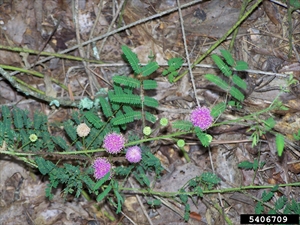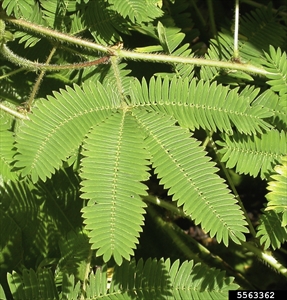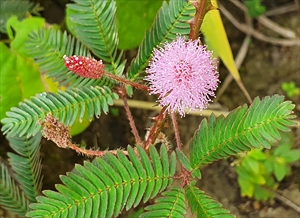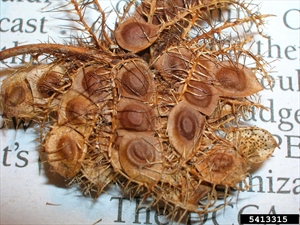- Widespread. Asia, Africa, North, South and Central America, Caribbean, Oceania. In many Pacific islands.
- Thrives in disturbed areas, tolerant, of shade and different soil types, producing abundant seed, invading plantations (bananas, citrus, coconuts, coffee, oil palm, papaya, rubber), pastures, crops, lawns, roadsides, and wasteland. Mimosine causes thyroid problems in cattle. A fire hazard when dead.
- Small prickly shrub, up to 50 cm, creeps. Stems brown to purple, woody, branched, with sharp thorns. Leaves, hairy, alternate along stems, bearing 1-2 pairs leaf-like branches, with paired dark green leaflets. Flower stalks, with thorns, bearing bright purplish-pink, oval, flower clusters, with long stamens giving a fluffy look. Seeds, in long seed pods, splitting into 2-4, 1-seeded segments bearing bristles. Root is long and strong
- Spread: seeds, by animals, clothing; use as ornamental; moved in soil, sand, gravel.
- Biosecurity: high risk of introduction via trade as an ornamental. Among 10 worst weeds in American Samoa, French Polynesia, Guam, Solomon Islands, Tonga. On Global Invasive Species Database of alien invasive species (IUCN, 2020).
- Biocontrol: Little known.
- Cultural control: hand weed (thorns!) or hoe; mulch; vehicle hygiene; prevent overgrazing (adjust stocking rate, forcing cattle to eat young plants).
- Chemical control: in Australia: MCPA + terbutryn; fluroxypyr; dicamba; picloram + triclopyr; hexazinone + diuron. In Fiji, 2,4-D; glyphosate.











